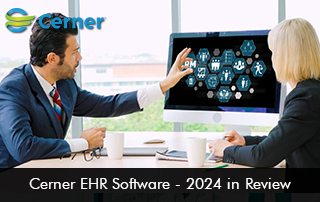Cerner EHR Software is a leading name in the industry, providing healthcare organizations with innovative tools to streamline patient care. As we reflect on 2024, Cerner EHR Software has continued to evolve, offering improved functionalities and features that address the needs of healthcare providers, patients, and administrators alike. This blog explores Cerner’s progress, its major updates, and its contributions to the healthcare ecosystem in 2024.
A Year of Innovation for Cerner EHRSoftware
Cerner EHR Software has always been focused on enhancing clinical efficiency and patient care especially in behavioral health EHR. In 2024, the software saw significant advancements to meet the challenges of an evolving healthcare landscape. Let’s take a closer look at the key innovations and updates this year.
Improved User Experience
One of the standout updates in 2024 was the improvement in user experience. Cerner introduced a more intuitive and user-friendly interface for its EHR software, helping healthcare professionals navigate the system more efficiently.
- Simplified Navigation: Providers can now easily access patient records, clinical notes, and test results without going through multiple tabs.
- Customization Options: Users can customize their dashboard to prioritize the tools and information most relevant to their workflows.
These changes have reduced the time spent on administrative tasks, allowing clinicians to focus more on patient care.
Enhanced EHR Software Interoperability
Interoperability remains a key focus area for EHR systems, and Cerner made significant strides in this domain in 2024.
- Improved Data Exchange: Cerner now integrates seamlessly with third-party applications, health information exchanges (HIEs), and other EHR systems.
- Cross-Platform Compatibility: Providers using different platforms can securely share and access patient data, improving care coordination.
- Standardized Data Formats: Compliance with FHIR (Fast Healthcare Interoperability Resources) and other industry standards ensures smoother data exchange.
These advancements have enabled healthcare organizations to achieve a more connected and collaborative approach to patient care.
Major Updates and New EHR Software Features
Cerner EHR has rolled out several new features and updates this year to address user feedback and emerging healthcare trends.
AI-Powered Decision Support
Artificial intelligence (AI) has become a game-changer in healthcare, and Cerner has embraced this technology to enhance clinical decision-making.
- Predictive Analytics: The software now offers tools that help identify at-risk patients through predictive analytics, allowing for early intervention.
- Clinical Decision Support (CDS): AI-driven CDS tools provide real-time recommendations based on patient data, improving accuracy and outcomes.
- Streamlined Workflows: Automation of repetitive tasks, such as documentation and coding, has improved operational efficiency.
These AI-powered tools have significantly reduced physician burnout and improved patient care quality.
Integration with EHR Software Telehealth Services
The demand for telehealth solutions continued to rise in 2024, and Cerner has adapted to this trend by enhancing its telehealth capabilities.
- Seamless Virtual Visits: Providers can schedule and conduct virtual consultations directly within the EHR platform.
- Integrated Patient Portals: Patients can access their health records, book appointments, and participate in video visits from a single platform.
- Secure Data Sharing: Telehealth visits are securely recorded, and data is stored within the patient’s medical history for future reference.
These integrations have enabled healthcare providers to deliver remote care without compromising the quality of patient interactions.
Enhanced Population Health Management
Cerner has strengthened its population health management tools, allowing healthcare organizations to address the needs of entire patient populations.
- Analytics and Reporting: Advanced analytics tools help identify trends, gaps in care, and opportunities for improvement.
- Chronic Disease Management: Providers can use data-driven insights to manage chronic conditions such as diabetes, hypertension, and heart disease.
- Community Health Initiatives: Cerner now supports programs that focus on preventive care and community wellness, improving overall health outcomes.
This feature has been particularly useful for Accountable Care Organizations (ACOs) and value-based care initiatives.
Addressing EHR Software Security and Compliance
With rising cybersecurity threats in healthcare, Cerner has prioritized data security and regulatory compliance in 2024.
Robust Cybersecurity Measures
Cerner introduced advanced security features to safeguard patient data and maintain trust among providers and patients.
- Multi-Factor Authentication (MFA): Ensuring only authorized personnel can access sensitive information.
- Real-Time Threat Detection: AI-based tools monitor and identify potential cyber threats, allowing for quick mitigation.
- Data Encryption: All patient data is encrypted at rest and in transit to prevent unauthorized access.
These measures have strengthened the security framework, reducing risks related to data breaches and cyberattacks.
Compliance with EHR Software Regulatory Standards
Cerner EHR continues to meet evolving healthcare regulations, including:
- HIPAA Compliance: Protecting patient privacy and data security.
- ONC Certification: Ensuring the software meets federal interoperability and usability standards.
- CMS Requirements: Supporting healthcare organizations participating in Medicare and Medicaid programs.
By prioritizing compliance, Cerner has ensured healthcare providers remain aligned with industry regulations and policies.
User Feedback and Customer Support
Cerner has worked hard to gather feedback from its users and make meaningful changes to the software.
Listening to Users
Throughout 2024, Cerner implemented multiple updates based on user suggestions.
- User Surveys: Regular surveys were conducted to identify areas for improvement.
- Pilot Programs: New features were tested with select healthcare organizations before full-scale implementation.
- User Forums: Cerner hosted forums and webinars to engage with its customers and understand their pain points.
This collaborative approach has helped Cerner develop a product that truly meets the needs of its end users.
Enhanced Customer Support
Cerner has also improved its customer support infrastructure, ensuring healthcare organizations receive timely assistance.
- 24/7 Support: Dedicated support teams are available round the clock to resolve technical issues.
- Training Programs: Comprehensive training programs help users get the most out of the software.
- Resource Library: A library of tutorials, guides, and videos allows users to find quick answers to common problems.
These initiatives have resulted in higher user satisfaction and a smoother experience with the software.
Challenges and Areas for EHR Software Improvement
While Cerner EHR Software has made significant progress in 2024, there are still areas that require attention.
Complexity for New Users
Some new users continue to find the system complex when getting started. While the user interface has improved, further simplification could make onboarding smoother for first-time users.
High Implementation Costs of EHR Software
The cost of implementing Cerner EHR remains a challenge for smaller healthcare organizations. Cerner could explore more affordable pricing models or support programs to make the software accessible to all.
System Downtime
Occasional system downtimes have been reported, which can disrupt workflows. Enhancing system stability and reducing outages should be a key priority moving forward.
The Road Ahead for Cerner EHR Software
Looking ahead, Cerner is well-positioned to lead the EHR market with its focus on innovation, user satisfaction, and data-driven healthcare solutions. In 2025, we can expect:
- Further AI Integration: Expanding AI capabilities to enhance predictive care and clinical outcomes.
- Advanced Data Analytics: Tools for real-time insights to improve population health.
- Improved Telehealth Solutions: Making virtual care even more seamless and accessible.
Cerner’s continued commitment to solving healthcare challenges ensures it remains a trusted partner for providers and organizations worldwide.
Conclusion
Cerner EHR Software has had a remarkable 2024, marked by innovation, enhanced features, and a commitment to improving patient care. By addressing interoperability, improving user experience, and integrating advanced technologies like AI, Cerner has solidified its position as a leader in the EHR market. While challenges remain, the company’s forward-thinking approach and focus on user needs leave us optimistic about future developments.
As healthcare evolves, Cerner’s role in transforming patient care and streamlining clinical workflows will grow stronger.







